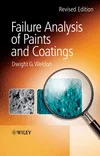Q&A: Coatings R&D Notebook


Additive Commonalities
Are there common roles for additives in all types of coating systems?Additives are employed to modify the performance of coatings and enhance specific application and dry-film-performance properties. For instance, waxes can improve scuff resistance whilst silicone oils and fatty acids enhance slip and anti-blocking characteristics. For UV systems, the absorption of light by additives (e.g., pigments) has to be minimized in the frequency range required to start the polymerization reactions. The main types of additives that are used in coatings, adhesives or inks include fillers, pigments, adhesion promoters, flatting agents, wetting agents, slip aids, and stabilizers (e.g., antioxidants and photo-stabilizers).
The use of stabilizers in coatings is often essential to improve the long-term service properties of the coating. For example, in a clear coating, a small amount of photo-stabilizer (0.5 to 1%) can improve resistance to photo-degradation and discoloration during weathering. In pigmented or filled systems, wetting agents are incorporated to promote the adhesion characteristics of the coating.
Forming Complex Network Structures
How are network structures generated in applied coating systems?The development of high-quality coating systems requires the use of special energy-related chemical-reaction mechanisms to enable the formation of complex network structures.
These network-formation reactions take place between high-molecular-weight polymer chains containing reactive functional groups or between polymer chains and crosslinking oligomers. In understanding how the various energy sources and curing methods function, it should be noted that energies on the order of a few electron volts are often sufficient to break a chemical bond or raise a molecule to an electronically excited state. Therefore, in general, UV, EB, IR, microwave, and radio-frequency radiation sources can generate reactive chemical species similar to those produced by, for example, heating a coating in a conventional oven.
Compared to the conventional use of ovens to drive off solvents or water and to apply heat to cure coatings, adhesives and inks, radiation energy interacts directly with specially formulated materials that are usually applied as 100% solid systems, containing no volatile components. This direct action initiates a very rapid chemical reaction. The solid-state structural features in the cured coating created by these reactive processes generally remain in place unless new chemical degradation processes invade the applied coatings.
Additives' Influence on Film Forming
How do additives influence the minimum film-forming temperature of a latex coating?Zinc oxide is a low-cost hiding pigment, although the hide is not sufficient for many applications without the addition of titanium dioxide. Zinc oxide also has UV-blocking properties. When used in sufficient quantities, the pigment blocks UV radiation from reaching the surface below the coating.
The minimum film-forming temperature of a latex coating is the lowest temperature at which a film will form with a latex under specified conditions. The glass transition temperature (Tg) of the latex polymer is one of the major polymer film characteristics that influences the coalescence properties of the applied film. As part of the formulated coating, the latex particle's Tg can be affected by several variables. Coating components, such as surfactants, coalescence aids, cosolvents and plasticizers, can effectively lower the film-forming temperature.
These additives typically function by dissolving or partially dissolving into the latex polymer particle, enhancing the particle's mobility and interaction with other components of the formulation. These actions promote more rapid film coalescence at a lower temperature compared to the polymer alone. The rate of evaporation of these additives from the applied film governs the final film-formation characteristics.
When employed in typical quantities of 5% or less, these additives allow formulation of ambient dry gloss coatings using latexes with a Tg of 30 to 40°C and higher. In addition to coalescing efficiency, these agents can add hydrolytic stability, biodegradability, toxicity and odor, depending on the inherent chemical characteristics of the additive.
Looking for a reprint of this article?
From high-res PDFs to custom plaques, order your copy today!






